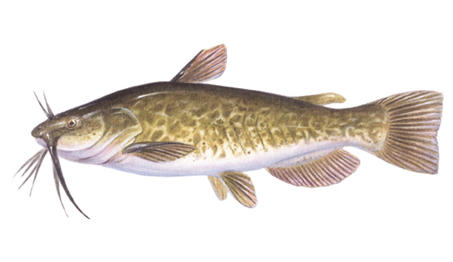Common Names: brown bullhead, bullhead, mudcat
Habitat
Brown bullheads are found throughout much of central and southern Ontario. Bullheads generally prefer warm, shallow water, where they are usually associated with the bottom. They prefer abundant weed growth with mud to sand bottoms, but can also be found in shallow areas of less productive lakes. They are extremely tolerant to degraded conditions; for example, they can survive in water up to 97ºF (36 ºC).
Spawning Patterns
Brown bullheads spawn in late spring to early summer (May to June) when water temperatures reach approximately 70 ºF (21 ºC). They spawn along mud or sand bottoms, usually near weeds, stumps or rocks. One or both of the parents guard the eggs until they hatch. The Diet of the Brown Bullhead Brown bullheads typically feed most actively at night. Their diet includes aquatic plants and algae, insects, worms, fish eggs, and small fish. Most feeding is done on or near the bottom. Age and Growth Ranges of the Brown Bullhead Very little information is available on the age and growth of bullheads. A bullhead’s age is determined by slicing the pectoral (front) bony fin ray into thin slices. These slices would have zones or “rings” similar to that of a tree. Generally, it would take bullheads in Ontario 3 to 4 years to reach 10” (25 cm) and they probably live to about 10 to 12 years.
Diet
Brown bullheads typically feed most actively at night. Their diet includes aquatic plants and algae, insects, worms, fish eggs, and small fish. Most feeding is done on or near the bottom.
Age and Size
Very little information is available on the age and growth of bullheads. A bullhead’s age is determined by slicing the pectoral (front) bony fin ray into thin slices. These slices would have zones or “rings” similar to that of a tree. Generally, it would take bullheads in Ontario 3 to 4 years to reach 10” (25 cm) and they probably live to about 10 to 12 years.
Fishing Tips
Bullheads are most easily caught at night, when they are most actively feeding, but they can be caught during the day as well. Live baits such as worms or minnows work well, as do doughballs and stinkbaits, fished on the bottom.
Fish illustration ©CURTIS ATWATER (www.natureartists.com/atwaterc.htm)









